Strategic Planning: Vision, Mission, Strategy & Stakeholder Impact
VerifiedAdded on 2023/06/10
|38
|11638
|426
Report
AI Summary
This report provides a detailed analysis of strategic planning, focusing on the interrelationship between an organization's vision, mission, and business strategy. It explains each concept, providing examples from Adidas and Emirates to illustrate key points. The report explores how external factors and stakeholder expectations influence organizational strategy, and it presents various strategy options using modeling tools. Furthermore, it discusses the structure of a strategic plan, stakeholder involvement, and dissemination processes to ensure stakeholder commitment. The report also covers monitoring systems for successful implementation of strategic plans, culminating in a strategic plan proposal for Adidas. This resource, contributed by a student, is available on Desklib, a platform offering a wide array of study tools and solved assignments.
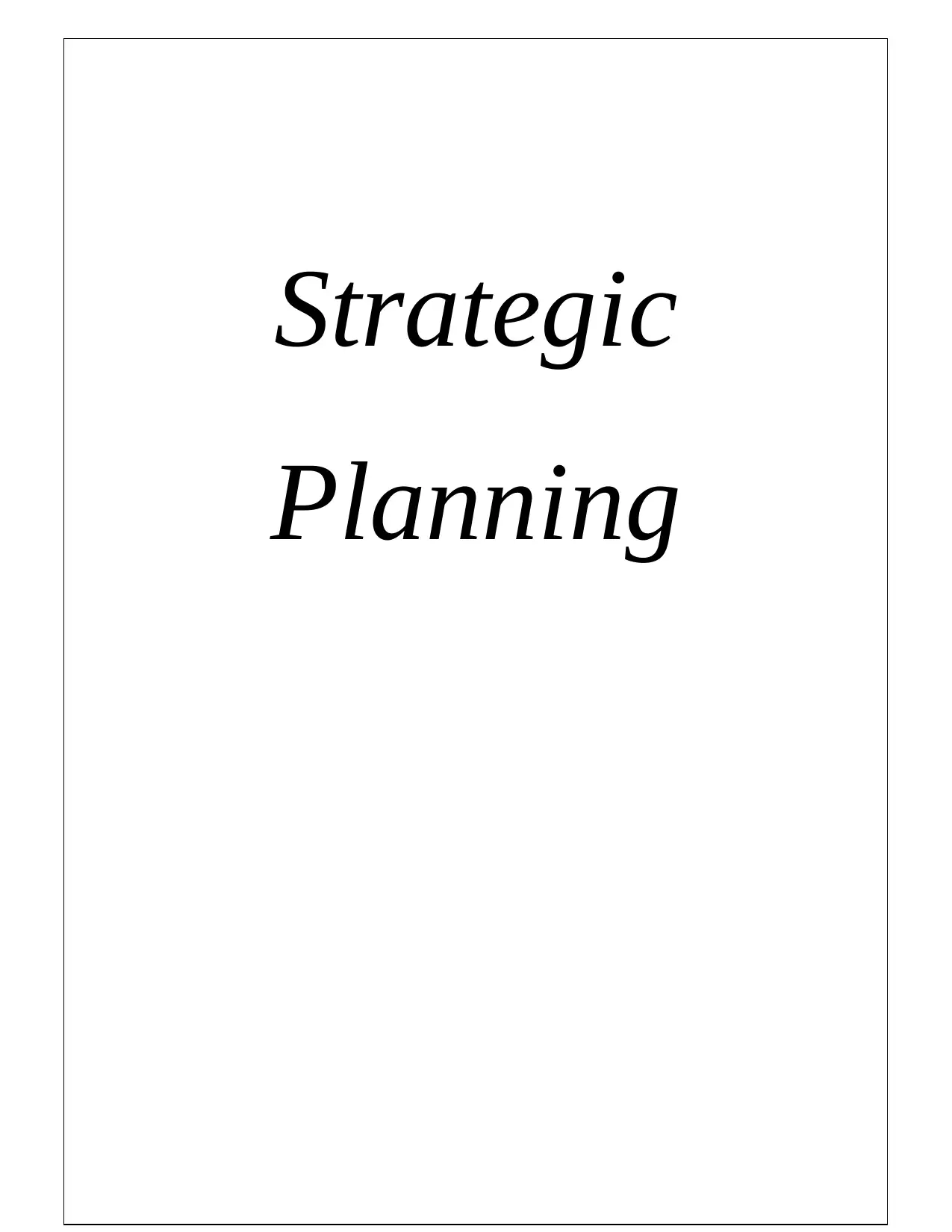
Strategic
Planning
Planning
Paraphrase This Document
Need a fresh take? Get an instant paraphrase of this document with our AI Paraphraser

2
Table of Contents
Task 1..............................................................................................................................................3
1.1 Explain organizational vision, mission, strategy and business plans and the relationships between
them........................................................................................................................................................3
1.2 Analysis of the mission and vision statements of named organization ............................................7
1M1: evaluates the impact of a named organization ’s vision and mission on its strategy.....................8
Task 2............................................................................................................................................11
2.1 Explain how external factors affect organization ............................................................................11
2.2 Evaluate how stakeholder expectations influence organization s...................................................12
2.3 Explain how changes in the external environment affect organizational strategy..........................13
2D1 Analyses of how external influences affect organizational strategy in a named organization ......14
Task 4............................................................................................................................................15
4.1 Strategy options for selected organization using modeling tools ...................................................15
4.2 Criteria for Reviewing the Potential Strategy Options.....................................................................17
4M1: Apply the criteria and evaluate the options for delivering the strategic direction of the
organization you have chosen. ............................................................................................................18
Evaluation of options for delivering the strategic direction for Adidas ................................................18
Task 5............................................................................................................................................22
5.1 The Structure of the Strategic Plan..................................................................................................22
5.2 Explain how stakeholders are involved in the formulation of the plan...........................................25
5.3 Provide a dissemination process to ensure stakeholders are informed and committed................26
to the plan............................................................................................................................................27
5M1 Create monitoring systems to ensure the successful implementation of strategic plan. ............29
5D1 Strategic Plan for Adidas ...............................................................................................................32
References.....................................................................................................................................34
Table of Contents
Task 1..............................................................................................................................................3
1.1 Explain organizational vision, mission, strategy and business plans and the relationships between
them........................................................................................................................................................3
1.2 Analysis of the mission and vision statements of named organization ............................................7
1M1: evaluates the impact of a named organization ’s vision and mission on its strategy.....................8
Task 2............................................................................................................................................11
2.1 Explain how external factors affect organization ............................................................................11
2.2 Evaluate how stakeholder expectations influence organization s...................................................12
2.3 Explain how changes in the external environment affect organizational strategy..........................13
2D1 Analyses of how external influences affect organizational strategy in a named organization ......14
Task 4............................................................................................................................................15
4.1 Strategy options for selected organization using modeling tools ...................................................15
4.2 Criteria for Reviewing the Potential Strategy Options.....................................................................17
4M1: Apply the criteria and evaluate the options for delivering the strategic direction of the
organization you have chosen. ............................................................................................................18
Evaluation of options for delivering the strategic direction for Adidas ................................................18
Task 5............................................................................................................................................22
5.1 The Structure of the Strategic Plan..................................................................................................22
5.2 Explain how stakeholders are involved in the formulation of the plan...........................................25
5.3 Provide a dissemination process to ensure stakeholders are informed and committed................26
to the plan............................................................................................................................................27
5M1 Create monitoring systems to ensure the successful implementation of strategic plan. ............29
5D1 Strategic Plan for Adidas ...............................................................................................................32
References.....................................................................................................................................34
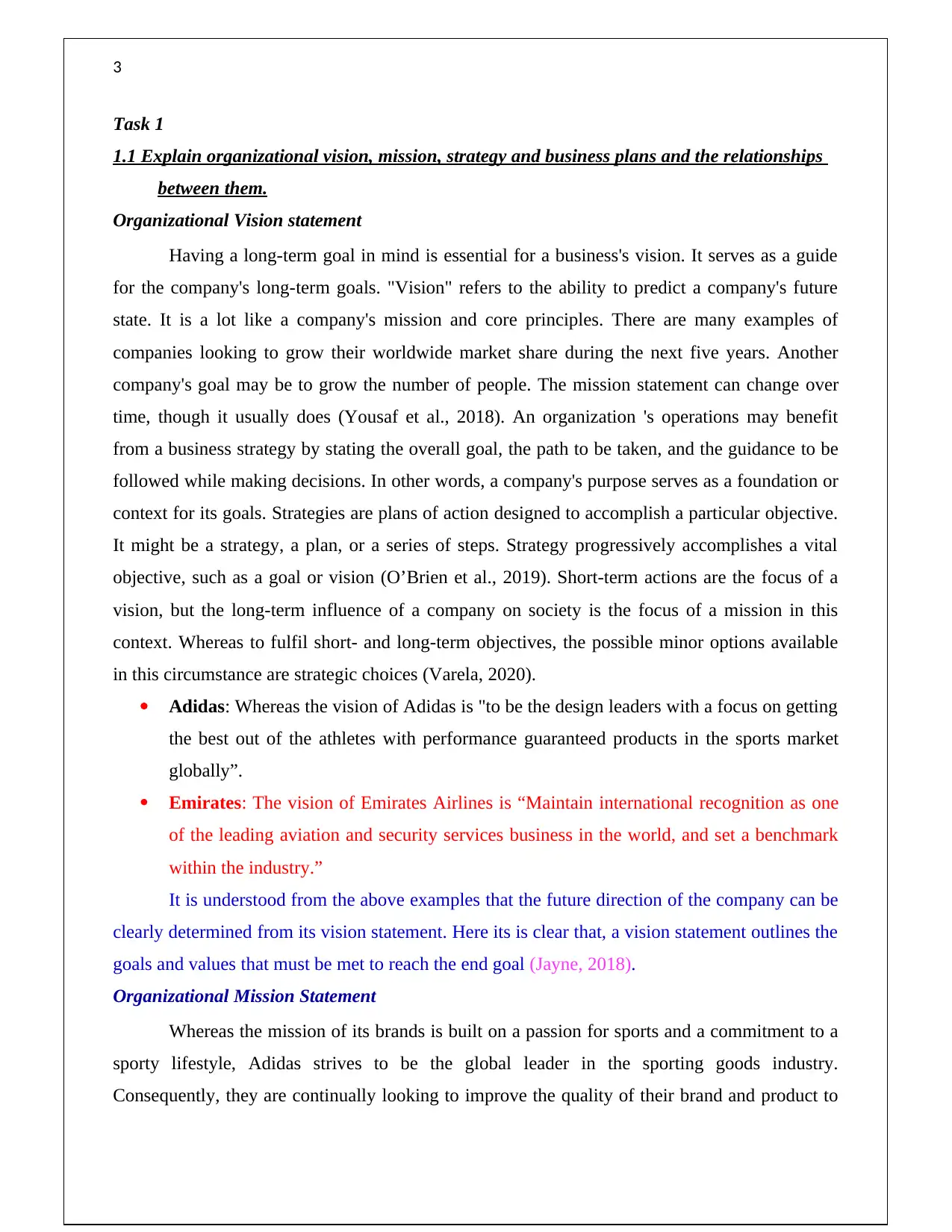
3
Task 1
1.1 Explain organizational vision, mission, strategy and business plans and the relationships
between them.
Organizational Vision statement
Having a long-term goal in mind is essential for a business's vision. It serves as a guide
for the company's long-term goals. "Vision" refers to the ability to predict a company's future
state. It is a lot like a company's mission and core principles. There are many examples of
companies looking to grow their worldwide market share during the next five years. Another
company's goal may be to grow the number of people. The mission statement can change over
time, though it usually does (Yousaf et al., 2018). An organization 's operations may benefit
from a business strategy by stating the overall goal, the path to be taken, and the guidance to be
followed while making decisions. In other words, a company's purpose serves as a foundation or
context for its goals. Strategies are plans of action designed to accomplish a particular objective.
It might be a strategy, a plan, or a series of steps. Strategy progressively accomplishes a vital
objective, such as a goal or vision (O’Brien et al., 2019). Short-term actions are the focus of a
vision, but the long-term influence of a company on society is the focus of a mission in this
context. Whereas to fulfil short- and long-term objectives, the possible minor options available
in this circumstance are strategic choices (Varela, 2020).
Adidas: Whereas the vision of Adidas is "to be the design leaders with a focus on getting
the best out of the athletes with performance guaranteed products in the sports market
globally”.
Emirates: The vision of Emirates Airlines is “Maintain international recognition as one
of the leading aviation and security services business in the world, and set a benchmark
within the industry.”
It is understood from the above examples that the future direction of the company can be
clearly determined from its vision statement. Here its is clear that, a vision statement outlines the
goals and values that must be met to reach the end goal (Jayne, 2018).
Organizational Mission Statement
Whereas the mission of its brands is built on a passion for sports and a commitment to a
sporty lifestyle, Adidas strives to be the global leader in the sporting goods industry.
Consequently, they are continually looking to improve the quality of their brand and product to
Task 1
1.1 Explain organizational vision, mission, strategy and business plans and the relationships
between them.
Organizational Vision statement
Having a long-term goal in mind is essential for a business's vision. It serves as a guide
for the company's long-term goals. "Vision" refers to the ability to predict a company's future
state. It is a lot like a company's mission and core principles. There are many examples of
companies looking to grow their worldwide market share during the next five years. Another
company's goal may be to grow the number of people. The mission statement can change over
time, though it usually does (Yousaf et al., 2018). An organization 's operations may benefit
from a business strategy by stating the overall goal, the path to be taken, and the guidance to be
followed while making decisions. In other words, a company's purpose serves as a foundation or
context for its goals. Strategies are plans of action designed to accomplish a particular objective.
It might be a strategy, a plan, or a series of steps. Strategy progressively accomplishes a vital
objective, such as a goal or vision (O’Brien et al., 2019). Short-term actions are the focus of a
vision, but the long-term influence of a company on society is the focus of a mission in this
context. Whereas to fulfil short- and long-term objectives, the possible minor options available
in this circumstance are strategic choices (Varela, 2020).
Adidas: Whereas the vision of Adidas is "to be the design leaders with a focus on getting
the best out of the athletes with performance guaranteed products in the sports market
globally”.
Emirates: The vision of Emirates Airlines is “Maintain international recognition as one
of the leading aviation and security services business in the world, and set a benchmark
within the industry.”
It is understood from the above examples that the future direction of the company can be
clearly determined from its vision statement. Here its is clear that, a vision statement outlines the
goals and values that must be met to reach the end goal (Jayne, 2018).
Organizational Mission Statement
Whereas the mission of its brands is built on a passion for sports and a commitment to a
sporty lifestyle, Adidas strives to be the global leader in the sporting goods industry.
Consequently, they are continually looking to improve the quality of their brand and product to
⊘ This is a preview!⊘
Do you want full access?
Subscribe today to unlock all pages.

Trusted by 1+ million students worldwide
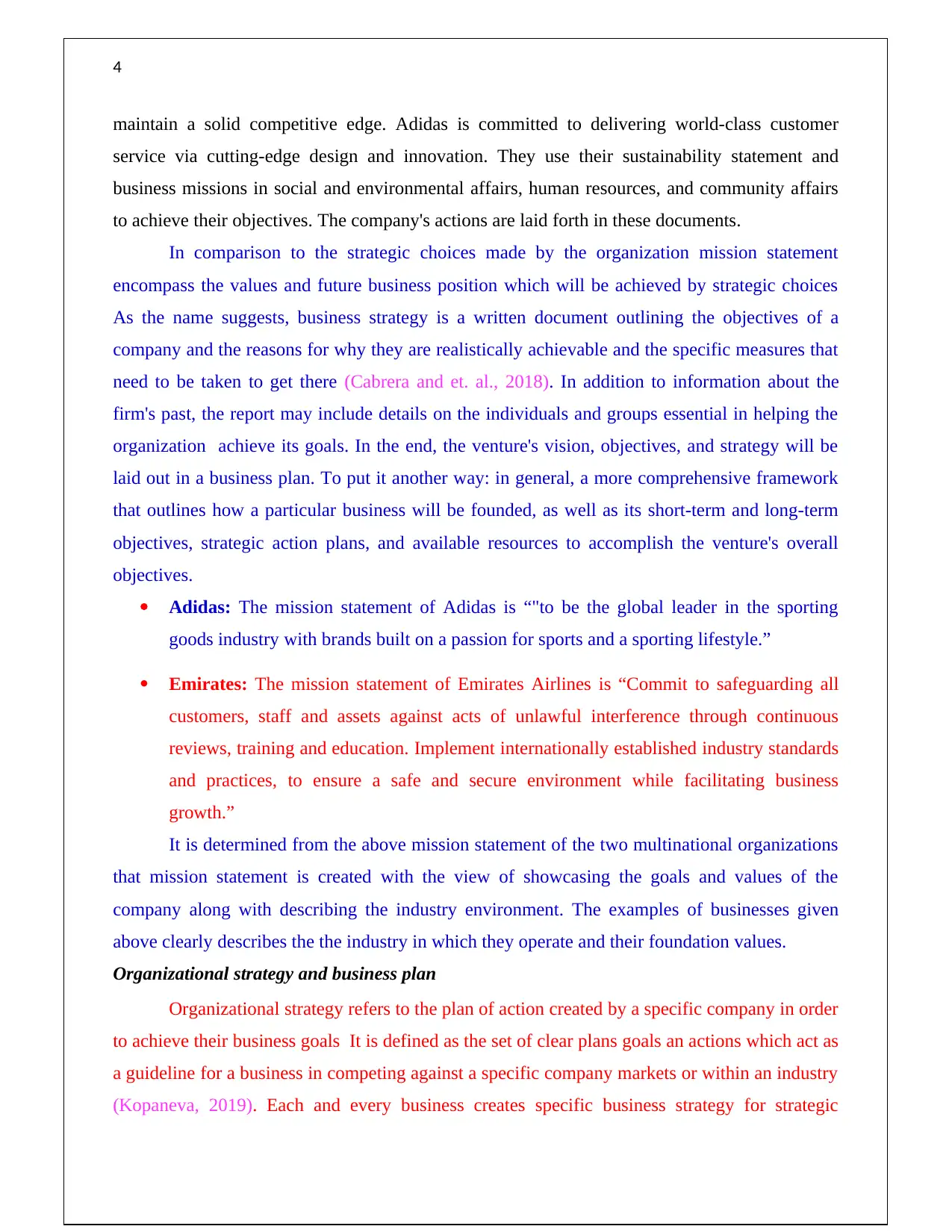
4
maintain a solid competitive edge. Adidas is committed to delivering world-class customer
service via cutting-edge design and innovation. They use their sustainability statement and
business missions in social and environmental affairs, human resources, and community affairs
to achieve their objectives. The company's actions are laid forth in these documents.
In comparison to the strategic choices made by the organization mission statement
encompass the values and future business position which will be achieved by strategic choices
As the name suggests, business strategy is a written document outlining the objectives of a
company and the reasons for why they are realistically achievable and the specific measures that
need to be taken to get there (Cabrera and et. al., 2018). In addition to information about the
firm's past, the report may include details on the individuals and groups essential in helping the
organization achieve its goals. In the end, the venture's vision, objectives, and strategy will be
laid out in a business plan. To put it another way: in general, a more comprehensive framework
that outlines how a particular business will be founded, as well as its short-term and long-term
objectives, strategic action plans, and available resources to accomplish the venture's overall
objectives.
Adidas: The mission statement of Adidas is “"to be the global leader in the sporting
goods industry with brands built on a passion for sports and a sporting lifestyle.”
Emirates: The mission statement of Emirates Airlines is “Commit to safeguarding all
customers, staff and assets against acts of unlawful interference through continuous
reviews, training and education. Implement internationally established industry standards
and practices, to ensure a safe and secure environment while facilitating business
growth.”
It is determined from the above mission statement of the two multinational organizations
that mission statement is created with the view of showcasing the goals and values of the
company along with describing the industry environment. The examples of businesses given
above clearly describes the the industry in which they operate and their foundation values.
Organizational strategy and business plan
Organizational strategy refers to the plan of action created by a specific company in order
to achieve their business goals It is defined as the set of clear plans goals an actions which act as
a guideline for a business in competing against a specific company markets or within an industry
(Kopaneva, 2019). Each and every business creates specific business strategy for strategic
maintain a solid competitive edge. Adidas is committed to delivering world-class customer
service via cutting-edge design and innovation. They use their sustainability statement and
business missions in social and environmental affairs, human resources, and community affairs
to achieve their objectives. The company's actions are laid forth in these documents.
In comparison to the strategic choices made by the organization mission statement
encompass the values and future business position which will be achieved by strategic choices
As the name suggests, business strategy is a written document outlining the objectives of a
company and the reasons for why they are realistically achievable and the specific measures that
need to be taken to get there (Cabrera and et. al., 2018). In addition to information about the
firm's past, the report may include details on the individuals and groups essential in helping the
organization achieve its goals. In the end, the venture's vision, objectives, and strategy will be
laid out in a business plan. To put it another way: in general, a more comprehensive framework
that outlines how a particular business will be founded, as well as its short-term and long-term
objectives, strategic action plans, and available resources to accomplish the venture's overall
objectives.
Adidas: The mission statement of Adidas is “"to be the global leader in the sporting
goods industry with brands built on a passion for sports and a sporting lifestyle.”
Emirates: The mission statement of Emirates Airlines is “Commit to safeguarding all
customers, staff and assets against acts of unlawful interference through continuous
reviews, training and education. Implement internationally established industry standards
and practices, to ensure a safe and secure environment while facilitating business
growth.”
It is determined from the above mission statement of the two multinational organizations
that mission statement is created with the view of showcasing the goals and values of the
company along with describing the industry environment. The examples of businesses given
above clearly describes the the industry in which they operate and their foundation values.
Organizational strategy and business plan
Organizational strategy refers to the plan of action created by a specific company in order
to achieve their business goals It is defined as the set of clear plans goals an actions which act as
a guideline for a business in competing against a specific company markets or within an industry
(Kopaneva, 2019). Each and every business creates specific business strategy for strategic
Paraphrase This Document
Need a fresh take? Get an instant paraphrase of this document with our AI Paraphraser

5
management of their organization which helps the company take actions towards achieving
continuous success in their specific field. It is important to construct a detailed business strategy
in order to ensure that the company is able to move towards direction of success. The overall
strategy of an organization includes different elements such as its vision statement mission
statement and values which help guide the organization towards ethically and lawfully
conducting a business within the interests of various stakeholders (Morton, Wilson and Cooke,
2020).
A business strategy includes combination of all the decisions and actions which are
performed by a company in order to achieve its business gold and secure a beneficial position in
its industry or market. A strong business strategy creates a strong foundation for a company and
acts as a road map towards achieving its specific objectives which increases it's important as
creation of a suitable strategy as an organization survive for a long term in the crowd of
overwhelming competitors (Foss, McCaffrey and Dorobat, 2022). Business strategy helps a
company create suitable plan for achieving goals and objectives so that they are able to fulfill its
long term objectives in a timely manner and are able to reach the position in their market where
it is intended. In addition to this business strategy also helps improve efficiency and
effectiveness of the organization as it helps ensure that the plan is created to utilize various
resources in an optimal manner making business activities more efficient and effective
automatically.
After creation of a business strategy the next element which arises is creation of a
business plan. A business plan is defined as a document which includes details related to a
company's objectives and the ways in which these objectives will be achieved. Our business plan
includes information about the ways in which marketing financial and operational functions of
an organization will be completed so that it is able to achieve its overall business objectives in a
timely manner. Start up businesses and established businesses create business plan so that they
are able to move towards the direction of success and achieve their business strategy and
strategic objectives (Gagné, 2018).
Relationship between an organization ’s vision, mission and business strategy
The mission of an organization is based on the organization 's vision. An organization al
vision conveys the overall aims and objectives of an organization , while a mission statement
communicates the "why," "who," and "how" of an organization 's vision. The mission of a firm
management of their organization which helps the company take actions towards achieving
continuous success in their specific field. It is important to construct a detailed business strategy
in order to ensure that the company is able to move towards direction of success. The overall
strategy of an organization includes different elements such as its vision statement mission
statement and values which help guide the organization towards ethically and lawfully
conducting a business within the interests of various stakeholders (Morton, Wilson and Cooke,
2020).
A business strategy includes combination of all the decisions and actions which are
performed by a company in order to achieve its business gold and secure a beneficial position in
its industry or market. A strong business strategy creates a strong foundation for a company and
acts as a road map towards achieving its specific objectives which increases it's important as
creation of a suitable strategy as an organization survive for a long term in the crowd of
overwhelming competitors (Foss, McCaffrey and Dorobat, 2022). Business strategy helps a
company create suitable plan for achieving goals and objectives so that they are able to fulfill its
long term objectives in a timely manner and are able to reach the position in their market where
it is intended. In addition to this business strategy also helps improve efficiency and
effectiveness of the organization as it helps ensure that the plan is created to utilize various
resources in an optimal manner making business activities more efficient and effective
automatically.
After creation of a business strategy the next element which arises is creation of a
business plan. A business plan is defined as a document which includes details related to a
company's objectives and the ways in which these objectives will be achieved. Our business plan
includes information about the ways in which marketing financial and operational functions of
an organization will be completed so that it is able to achieve its overall business objectives in a
timely manner. Start up businesses and established businesses create business plan so that they
are able to move towards the direction of success and achieve their business strategy and
strategic objectives (Gagné, 2018).
Relationship between an organization ’s vision, mission and business strategy
The mission of an organization is based on the organization 's vision. An organization al
vision conveys the overall aims and objectives of an organization , while a mission statement
communicates the "why," "who," and "how" of an organization 's vision. The mission of a firm
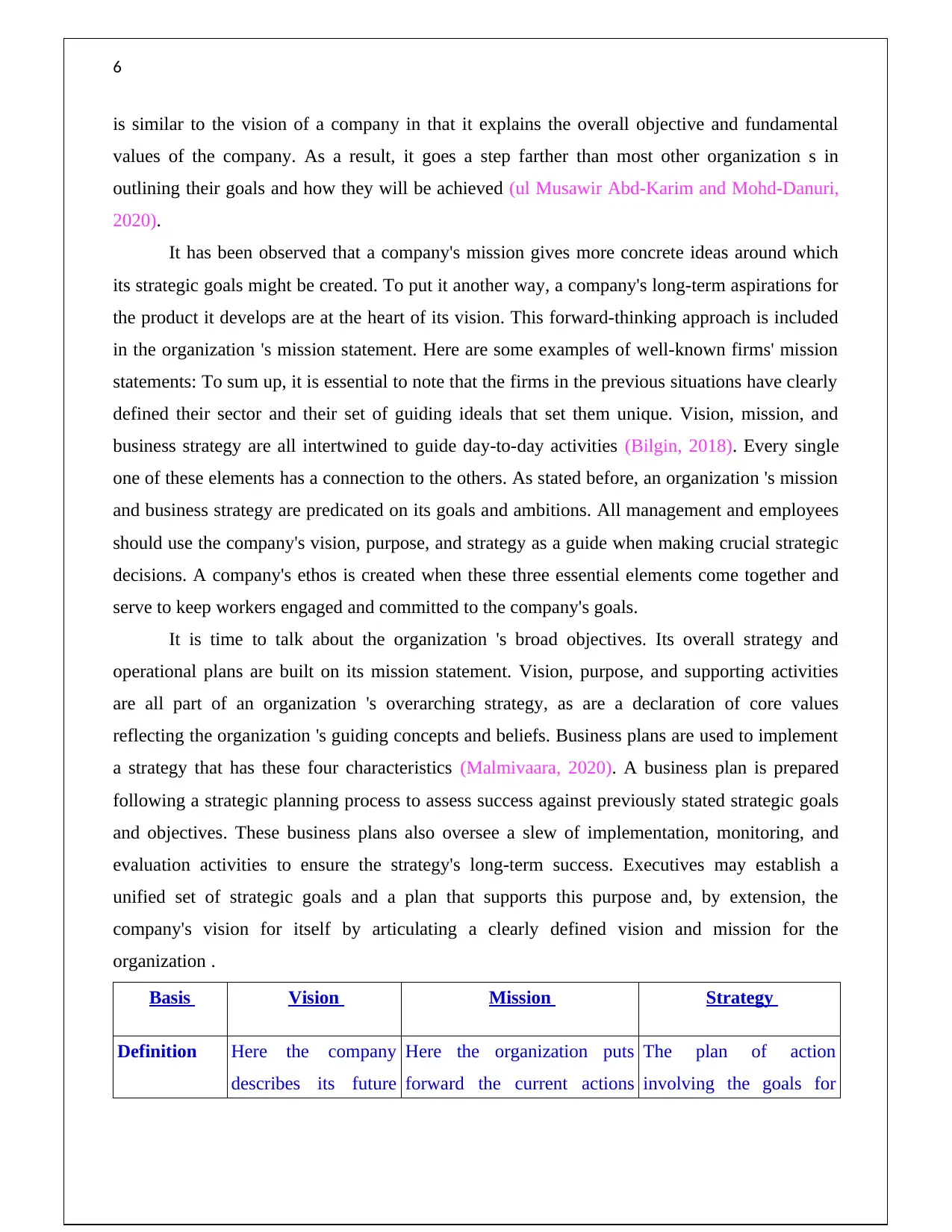
6
is similar to the vision of a company in that it explains the overall objective and fundamental
values of the company. As a result, it goes a step farther than most other organization s in
outlining their goals and how they will be achieved (ul Musawir Abd-Karim and Mohd-Danuri,
2020).
It has been observed that a company's mission gives more concrete ideas around which
its strategic goals might be created. To put it another way, a company's long-term aspirations for
the product it develops are at the heart of its vision. This forward-thinking approach is included
in the organization 's mission statement. Here are some examples of well-known firms' mission
statements: To sum up, it is essential to note that the firms in the previous situations have clearly
defined their sector and their set of guiding ideals that set them unique. Vision, mission, and
business strategy are all intertwined to guide day-to-day activities (Bilgin, 2018). Every single
one of these elements has a connection to the others. As stated before, an organization 's mission
and business strategy are predicated on its goals and ambitions. All management and employees
should use the company's vision, purpose, and strategy as a guide when making crucial strategic
decisions. A company's ethos is created when these three essential elements come together and
serve to keep workers engaged and committed to the company's goals.
It is time to talk about the organization 's broad objectives. Its overall strategy and
operational plans are built on its mission statement. Vision, purpose, and supporting activities
are all part of an organization 's overarching strategy, as are a declaration of core values
reflecting the organization 's guiding concepts and beliefs. Business plans are used to implement
a strategy that has these four characteristics (Malmivaara, 2020). A business plan is prepared
following a strategic planning process to assess success against previously stated strategic goals
and objectives. These business plans also oversee a slew of implementation, monitoring, and
evaluation activities to ensure the strategy's long-term success. Executives may establish a
unified set of strategic goals and a plan that supports this purpose and, by extension, the
company's vision for itself by articulating a clearly defined vision and mission for the
organization .
Basis Vision Mission Strategy
Definition Here the company
describes its future
Here the organization puts
forward the current actions
The plan of action
involving the goals for
is similar to the vision of a company in that it explains the overall objective and fundamental
values of the company. As a result, it goes a step farther than most other organization s in
outlining their goals and how they will be achieved (ul Musawir Abd-Karim and Mohd-Danuri,
2020).
It has been observed that a company's mission gives more concrete ideas around which
its strategic goals might be created. To put it another way, a company's long-term aspirations for
the product it develops are at the heart of its vision. This forward-thinking approach is included
in the organization 's mission statement. Here are some examples of well-known firms' mission
statements: To sum up, it is essential to note that the firms in the previous situations have clearly
defined their sector and their set of guiding ideals that set them unique. Vision, mission, and
business strategy are all intertwined to guide day-to-day activities (Bilgin, 2018). Every single
one of these elements has a connection to the others. As stated before, an organization 's mission
and business strategy are predicated on its goals and ambitions. All management and employees
should use the company's vision, purpose, and strategy as a guide when making crucial strategic
decisions. A company's ethos is created when these three essential elements come together and
serve to keep workers engaged and committed to the company's goals.
It is time to talk about the organization 's broad objectives. Its overall strategy and
operational plans are built on its mission statement. Vision, purpose, and supporting activities
are all part of an organization 's overarching strategy, as are a declaration of core values
reflecting the organization 's guiding concepts and beliefs. Business plans are used to implement
a strategy that has these four characteristics (Malmivaara, 2020). A business plan is prepared
following a strategic planning process to assess success against previously stated strategic goals
and objectives. These business plans also oversee a slew of implementation, monitoring, and
evaluation activities to ensure the strategy's long-term success. Executives may establish a
unified set of strategic goals and a plan that supports this purpose and, by extension, the
company's vision for itself by articulating a clearly defined vision and mission for the
organization .
Basis Vision Mission Strategy
Definition Here the company
describes its future
Here the organization puts
forward the current actions
The plan of action
involving the goals for
⊘ This is a preview!⊘
Do you want full access?
Subscribe today to unlock all pages.

Trusted by 1+ million students worldwide
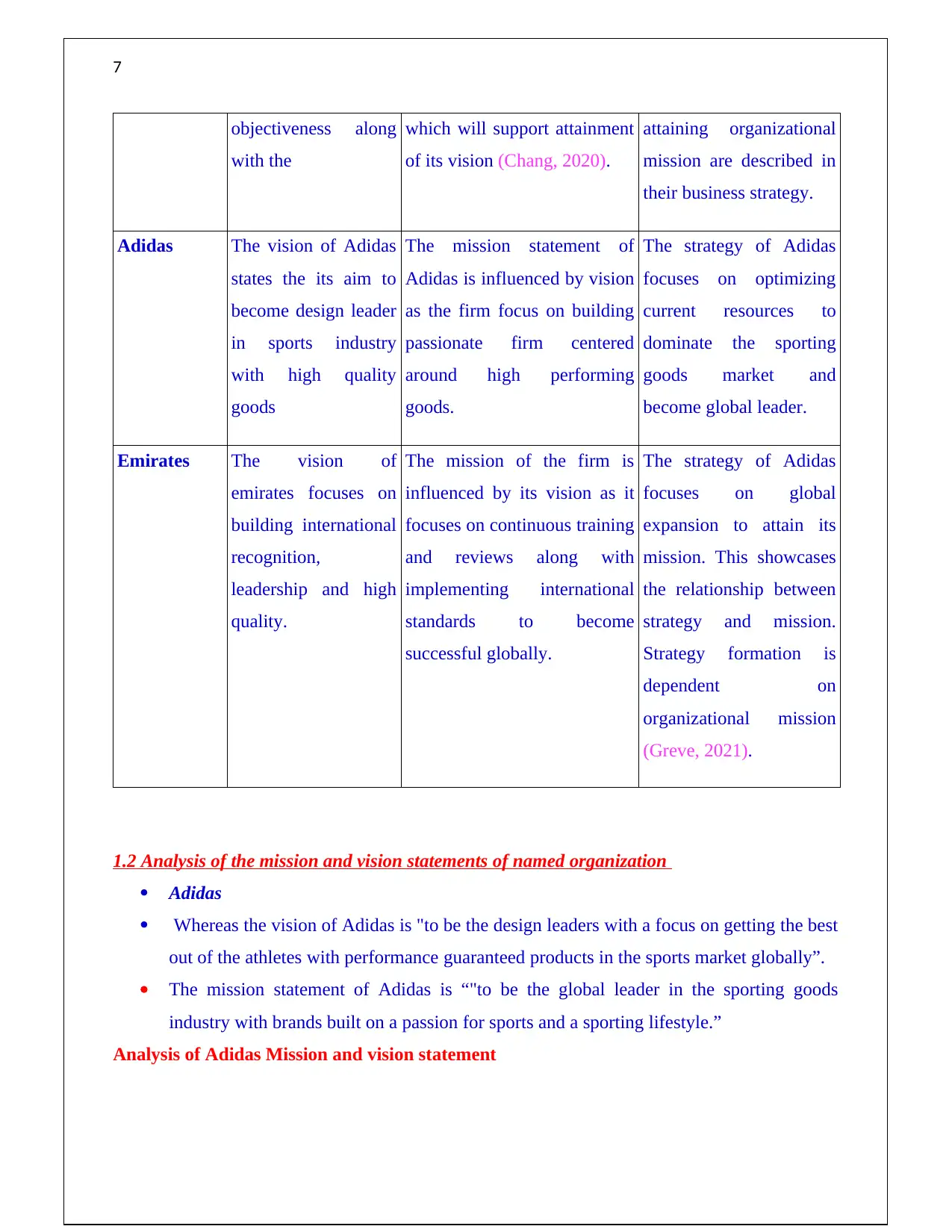
7
objectiveness along
with the
which will support attainment
of its vision (Chang, 2020).
attaining organizational
mission are described in
their business strategy.
Adidas The vision of Adidas
states the its aim to
become design leader
in sports industry
with high quality
goods
The mission statement of
Adidas is influenced by vision
as the firm focus on building
passionate firm centered
around high performing
goods.
The strategy of Adidas
focuses on optimizing
current resources to
dominate the sporting
goods market and
become global leader.
Emirates The vision of
emirates focuses on
building international
recognition,
leadership and high
quality.
The mission of the firm is
influenced by its vision as it
focuses on continuous training
and reviews along with
implementing international
standards to become
successful globally.
The strategy of Adidas
focuses on global
expansion to attain its
mission. This showcases
the relationship between
strategy and mission.
Strategy formation is
dependent on
organizational mission
(Greve, 2021).
1.2 Analysis of the mission and vision statements of named organization
Adidas
Whereas the vision of Adidas is "to be the design leaders with a focus on getting the best
out of the athletes with performance guaranteed products in the sports market globally”.
The mission statement of Adidas is “"to be the global leader in the sporting goods
industry with brands built on a passion for sports and a sporting lifestyle.”
Analysis of Adidas Mission and vision statement
objectiveness along
with the
which will support attainment
of its vision (Chang, 2020).
attaining organizational
mission are described in
their business strategy.
Adidas The vision of Adidas
states the its aim to
become design leader
in sports industry
with high quality
goods
The mission statement of
Adidas is influenced by vision
as the firm focus on building
passionate firm centered
around high performing
goods.
The strategy of Adidas
focuses on optimizing
current resources to
dominate the sporting
goods market and
become global leader.
Emirates The vision of
emirates focuses on
building international
recognition,
leadership and high
quality.
The mission of the firm is
influenced by its vision as it
focuses on continuous training
and reviews along with
implementing international
standards to become
successful globally.
The strategy of Adidas
focuses on global
expansion to attain its
mission. This showcases
the relationship between
strategy and mission.
Strategy formation is
dependent on
organizational mission
(Greve, 2021).
1.2 Analysis of the mission and vision statements of named organization
Adidas
Whereas the vision of Adidas is "to be the design leaders with a focus on getting the best
out of the athletes with performance guaranteed products in the sports market globally”.
The mission statement of Adidas is “"to be the global leader in the sporting goods
industry with brands built on a passion for sports and a sporting lifestyle.”
Analysis of Adidas Mission and vision statement
Paraphrase This Document
Need a fresh take? Get an instant paraphrase of this document with our AI Paraphraser
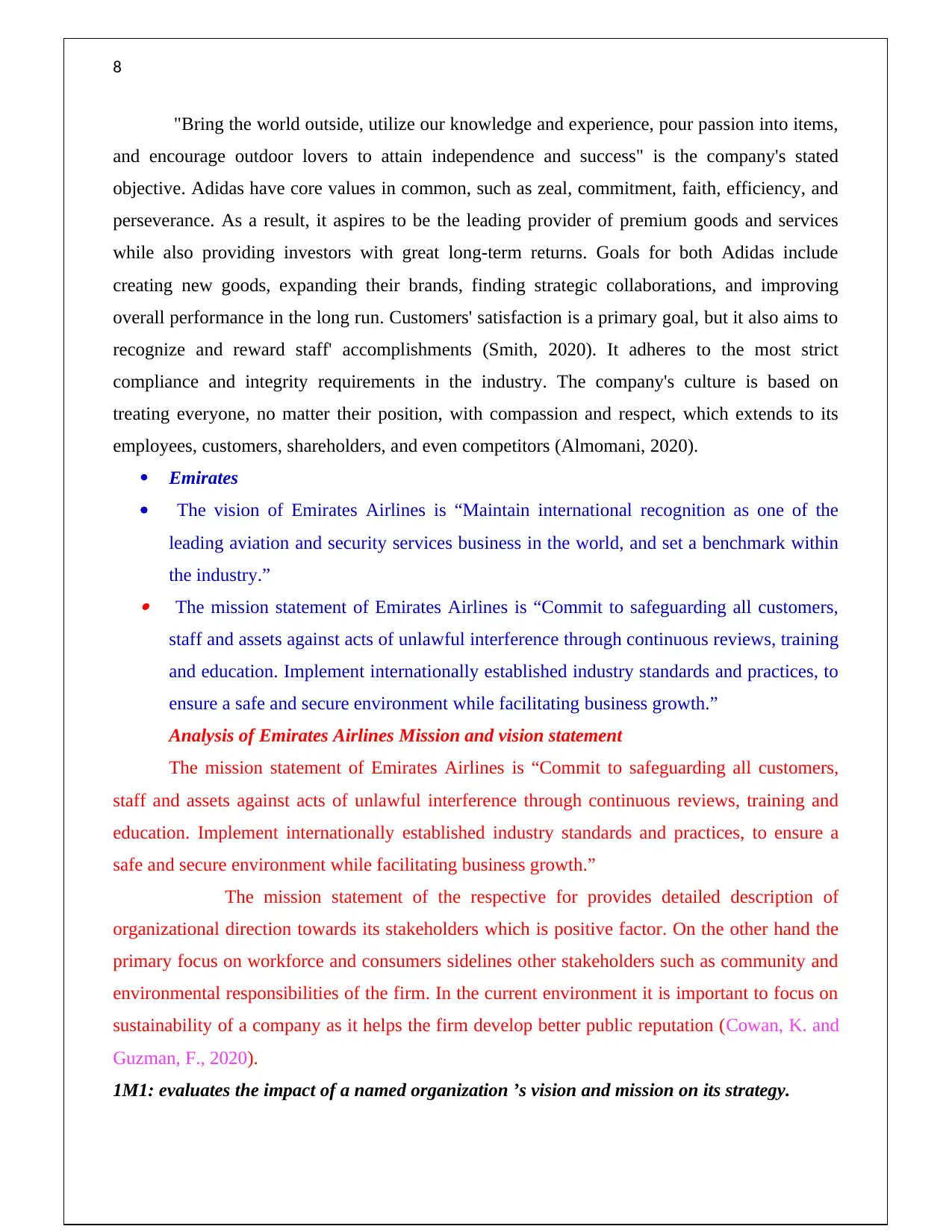
8
"Bring the world outside, utilize our knowledge and experience, pour passion into items,
and encourage outdoor lovers to attain independence and success" is the company's stated
objective. Adidas have core values in common, such as zeal, commitment, faith, efficiency, and
perseverance. As a result, it aspires to be the leading provider of premium goods and services
while also providing investors with great long-term returns. Goals for both Adidas include
creating new goods, expanding their brands, finding strategic collaborations, and improving
overall performance in the long run. Customers' satisfaction is a primary goal, but it also aims to
recognize and reward staff' accomplishments (Smith, 2020). It adheres to the most strict
compliance and integrity requirements in the industry. The company's culture is based on
treating everyone, no matter their position, with compassion and respect, which extends to its
employees, customers, shareholders, and even competitors (Almomani, 2020).
Emirates
The vision of Emirates Airlines is “Maintain international recognition as one of the
leading aviation and security services business in the world, and set a benchmark within
the industry.” The mission statement of Emirates Airlines is “Commit to safeguarding all customers,
staff and assets against acts of unlawful interference through continuous reviews, training
and education. Implement internationally established industry standards and practices, to
ensure a safe and secure environment while facilitating business growth.”
Analysis of Emirates Airlines Mission and vision statement
The mission statement of Emirates Airlines is “Commit to safeguarding all customers,
staff and assets against acts of unlawful interference through continuous reviews, training and
education. Implement internationally established industry standards and practices, to ensure a
safe and secure environment while facilitating business growth.”
The mission statement of the respective for provides detailed description of
organizational direction towards its stakeholders which is positive factor. On the other hand the
primary focus on workforce and consumers sidelines other stakeholders such as community and
environmental responsibilities of the firm. In the current environment it is important to focus on
sustainability of a company as it helps the firm develop better public reputation (Cowan, K. and
Guzman, F., 2020).
1M1: evaluates the impact of a named organization ’s vision and mission on its strategy.
"Bring the world outside, utilize our knowledge and experience, pour passion into items,
and encourage outdoor lovers to attain independence and success" is the company's stated
objective. Adidas have core values in common, such as zeal, commitment, faith, efficiency, and
perseverance. As a result, it aspires to be the leading provider of premium goods and services
while also providing investors with great long-term returns. Goals for both Adidas include
creating new goods, expanding their brands, finding strategic collaborations, and improving
overall performance in the long run. Customers' satisfaction is a primary goal, but it also aims to
recognize and reward staff' accomplishments (Smith, 2020). It adheres to the most strict
compliance and integrity requirements in the industry. The company's culture is based on
treating everyone, no matter their position, with compassion and respect, which extends to its
employees, customers, shareholders, and even competitors (Almomani, 2020).
Emirates
The vision of Emirates Airlines is “Maintain international recognition as one of the
leading aviation and security services business in the world, and set a benchmark within
the industry.” The mission statement of Emirates Airlines is “Commit to safeguarding all customers,
staff and assets against acts of unlawful interference through continuous reviews, training
and education. Implement internationally established industry standards and practices, to
ensure a safe and secure environment while facilitating business growth.”
Analysis of Emirates Airlines Mission and vision statement
The mission statement of Emirates Airlines is “Commit to safeguarding all customers,
staff and assets against acts of unlawful interference through continuous reviews, training and
education. Implement internationally established industry standards and practices, to ensure a
safe and secure environment while facilitating business growth.”
The mission statement of the respective for provides detailed description of
organizational direction towards its stakeholders which is positive factor. On the other hand the
primary focus on workforce and consumers sidelines other stakeholders such as community and
environmental responsibilities of the firm. In the current environment it is important to focus on
sustainability of a company as it helps the firm develop better public reputation (Cowan, K. and
Guzman, F., 2020).
1M1: evaluates the impact of a named organization ’s vision and mission on its strategy.
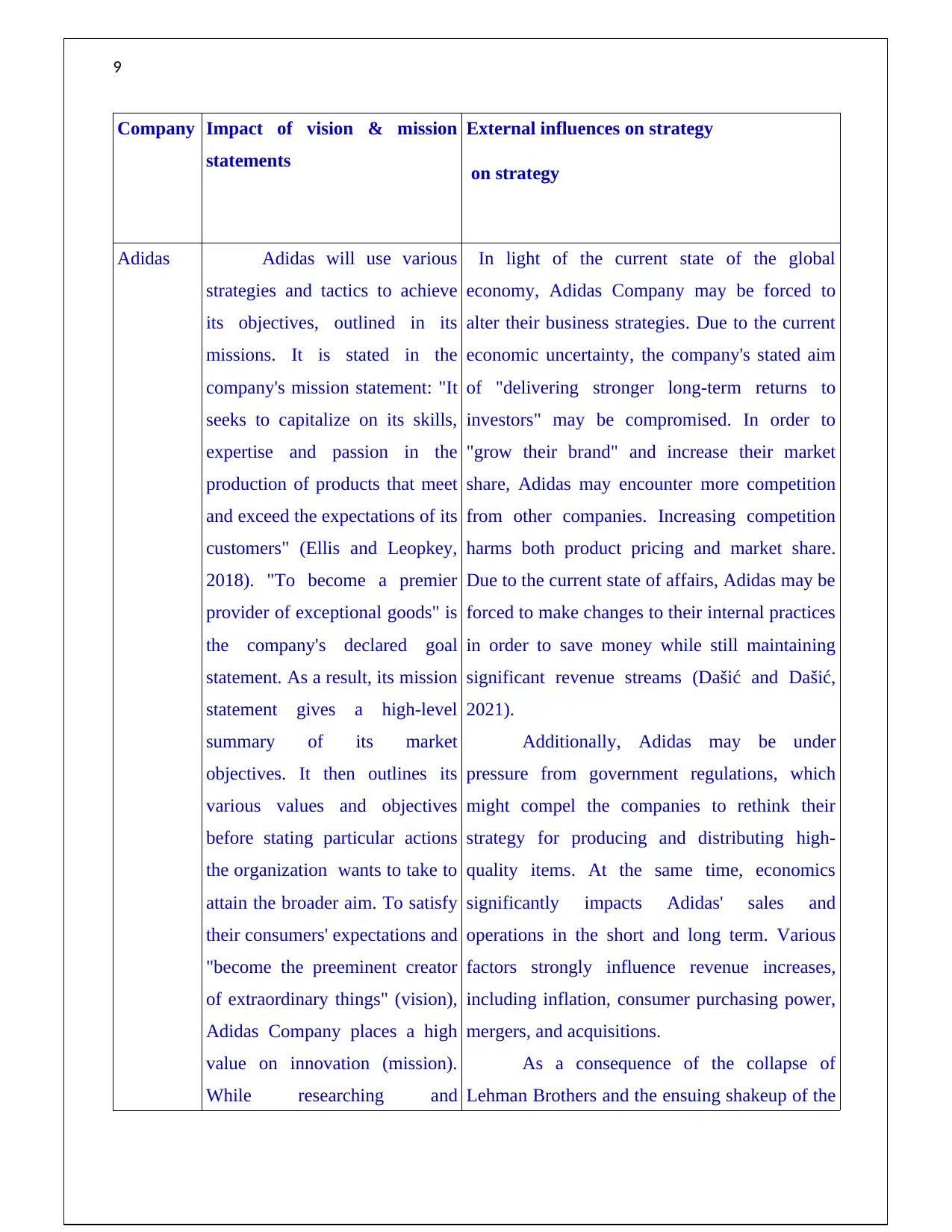
9
Company Impact of vision & mission
statements
External influences on strategy
on strategy
Adidas Adidas will use various
strategies and tactics to achieve
its objectives, outlined in its
missions. It is stated in the
company's mission statement: "It
seeks to capitalize on its skills,
expertise and passion in the
production of products that meet
and exceed the expectations of its
customers" (Ellis and Leopkey,
2018). "To become a premier
provider of exceptional goods" is
the company's declared goal
statement. As a result, its mission
statement gives a high-level
summary of its market
objectives. It then outlines its
various values and objectives
before stating particular actions
the organization wants to take to
attain the broader aim. To satisfy
their consumers' expectations and
"become the preeminent creator
of extraordinary things" (vision),
Adidas Company places a high
value on innovation (mission).
While researching and
In light of the current state of the global
economy, Adidas Company may be forced to
alter their business strategies. Due to the current
economic uncertainty, the company's stated aim
of "delivering stronger long-term returns to
investors" may be compromised. In order to
"grow their brand" and increase their market
share, Adidas may encounter more competition
from other companies. Increasing competition
harms both product pricing and market share.
Due to the current state of affairs, Adidas may be
forced to make changes to their internal practices
in order to save money while still maintaining
significant revenue streams (Dašić and Dašić,
2021).
Additionally, Adidas may be under
pressure from government regulations, which
might compel the companies to rethink their
strategy for producing and distributing high-
quality items. At the same time, economics
significantly impacts Adidas' sales and
operations in the short and long term. Various
factors strongly influence revenue increases,
including inflation, consumer purchasing power,
mergers, and acquisitions.
As a consequence of the collapse of
Lehman Brothers and the ensuing shakeup of the
Company Impact of vision & mission
statements
External influences on strategy
on strategy
Adidas Adidas will use various
strategies and tactics to achieve
its objectives, outlined in its
missions. It is stated in the
company's mission statement: "It
seeks to capitalize on its skills,
expertise and passion in the
production of products that meet
and exceed the expectations of its
customers" (Ellis and Leopkey,
2018). "To become a premier
provider of exceptional goods" is
the company's declared goal
statement. As a result, its mission
statement gives a high-level
summary of its market
objectives. It then outlines its
various values and objectives
before stating particular actions
the organization wants to take to
attain the broader aim. To satisfy
their consumers' expectations and
"become the preeminent creator
of extraordinary things" (vision),
Adidas Company places a high
value on innovation (mission).
While researching and
In light of the current state of the global
economy, Adidas Company may be forced to
alter their business strategies. Due to the current
economic uncertainty, the company's stated aim
of "delivering stronger long-term returns to
investors" may be compromised. In order to
"grow their brand" and increase their market
share, Adidas may encounter more competition
from other companies. Increasing competition
harms both product pricing and market share.
Due to the current state of affairs, Adidas may be
forced to make changes to their internal practices
in order to save money while still maintaining
significant revenue streams (Dašić and Dašić,
2021).
Additionally, Adidas may be under
pressure from government regulations, which
might compel the companies to rethink their
strategy for producing and distributing high-
quality items. At the same time, economics
significantly impacts Adidas' sales and
operations in the short and long term. Various
factors strongly influence revenue increases,
including inflation, consumer purchasing power,
mergers, and acquisitions.
As a consequence of the collapse of
Lehman Brothers and the ensuing shakeup of the
⊘ This is a preview!⊘
Do you want full access?
Subscribe today to unlock all pages.

Trusted by 1+ million students worldwide

10
developing new markets, the
company will build strategic
relationships and steadily
improve its overall performance
(AltunEkinci, 2018).
Several world-class
sporting events, including the
Olympics, are sponsored by
Adidas. Sponsorship deals have
been struck with the Football
Association and the Olympic
Committee. In addition, FIFA
could secure sponsorship rights
for the next World Cup. In 2009,
Adidas extended their contract
with the European Football
Association for the European
Championships, the Champions
League, and UEFA Euro 2012.
Adidas has also partnered with
FIFA in the past. For the 2006-
2007 season, the NBA and the
company have signed an 11-year
international merchandising
agreement (Yang and Luo,
2019). Adidas has been selected
as the official uniform and gear
supplier for the NBA
Development League, and
Women's National Basketball
Association, among other
financial sector, the global economy has seen
one of the worst downturns in the last two years,
with job losses and unemployment reaching
historic levels. A large majority of people
worldwide have begun living off their savings
due to the global financial
crisis(Anagnostopoulos, 2020). Adidas' net profit
margins are likely to shrink due to the Asian
economic crisis. A wide range of economic
issues might significantly impact Adidas and
other industry players.
Legal and regulatory constraints
profoundly affect the positioning of a brand and
its advertising strategies. An example of Nike's
difficulties establishing its brand in Spain is its
trademark dispute, which prevented Nike from
entering the country. In the end, the Supreme
Court ruled that the Nike brand was registered to
a former distributor (Stadler et al., 2022).
Whereas Nike products were permitted to bear
the company name, only the company's swoosh
emblem may be used. If the brand's reputation
had been damaged, this might have been a
significant setback. While a Supreme Court
decision in 2009 reversed a lower court
judgment, Nike struck gold when it appealed.
Adidas must guarantee that all of its
advertisements appropriately describe the
products being promoted in order to comply with
the Trade Descriptions Act of 1938. The Trade
Descriptions Act requires Adidas to ensure that
developing new markets, the
company will build strategic
relationships and steadily
improve its overall performance
(AltunEkinci, 2018).
Several world-class
sporting events, including the
Olympics, are sponsored by
Adidas. Sponsorship deals have
been struck with the Football
Association and the Olympic
Committee. In addition, FIFA
could secure sponsorship rights
for the next World Cup. In 2009,
Adidas extended their contract
with the European Football
Association for the European
Championships, the Champions
League, and UEFA Euro 2012.
Adidas has also partnered with
FIFA in the past. For the 2006-
2007 season, the NBA and the
company have signed an 11-year
international merchandising
agreement (Yang and Luo,
2019). Adidas has been selected
as the official uniform and gear
supplier for the NBA
Development League, and
Women's National Basketball
Association, among other
financial sector, the global economy has seen
one of the worst downturns in the last two years,
with job losses and unemployment reaching
historic levels. A large majority of people
worldwide have begun living off their savings
due to the global financial
crisis(Anagnostopoulos, 2020). Adidas' net profit
margins are likely to shrink due to the Asian
economic crisis. A wide range of economic
issues might significantly impact Adidas and
other industry players.
Legal and regulatory constraints
profoundly affect the positioning of a brand and
its advertising strategies. An example of Nike's
difficulties establishing its brand in Spain is its
trademark dispute, which prevented Nike from
entering the country. In the end, the Supreme
Court ruled that the Nike brand was registered to
a former distributor (Stadler et al., 2022).
Whereas Nike products were permitted to bear
the company name, only the company's swoosh
emblem may be used. If the brand's reputation
had been damaged, this might have been a
significant setback. While a Supreme Court
decision in 2009 reversed a lower court
judgment, Nike struck gold when it appealed.
Adidas must guarantee that all of its
advertisements appropriately describe the
products being promoted in order to comply with
the Trade Descriptions Act of 1938. The Trade
Descriptions Act requires Adidas to ensure that
Paraphrase This Document
Need a fresh take? Get an instant paraphrase of this document with our AI Paraphraser
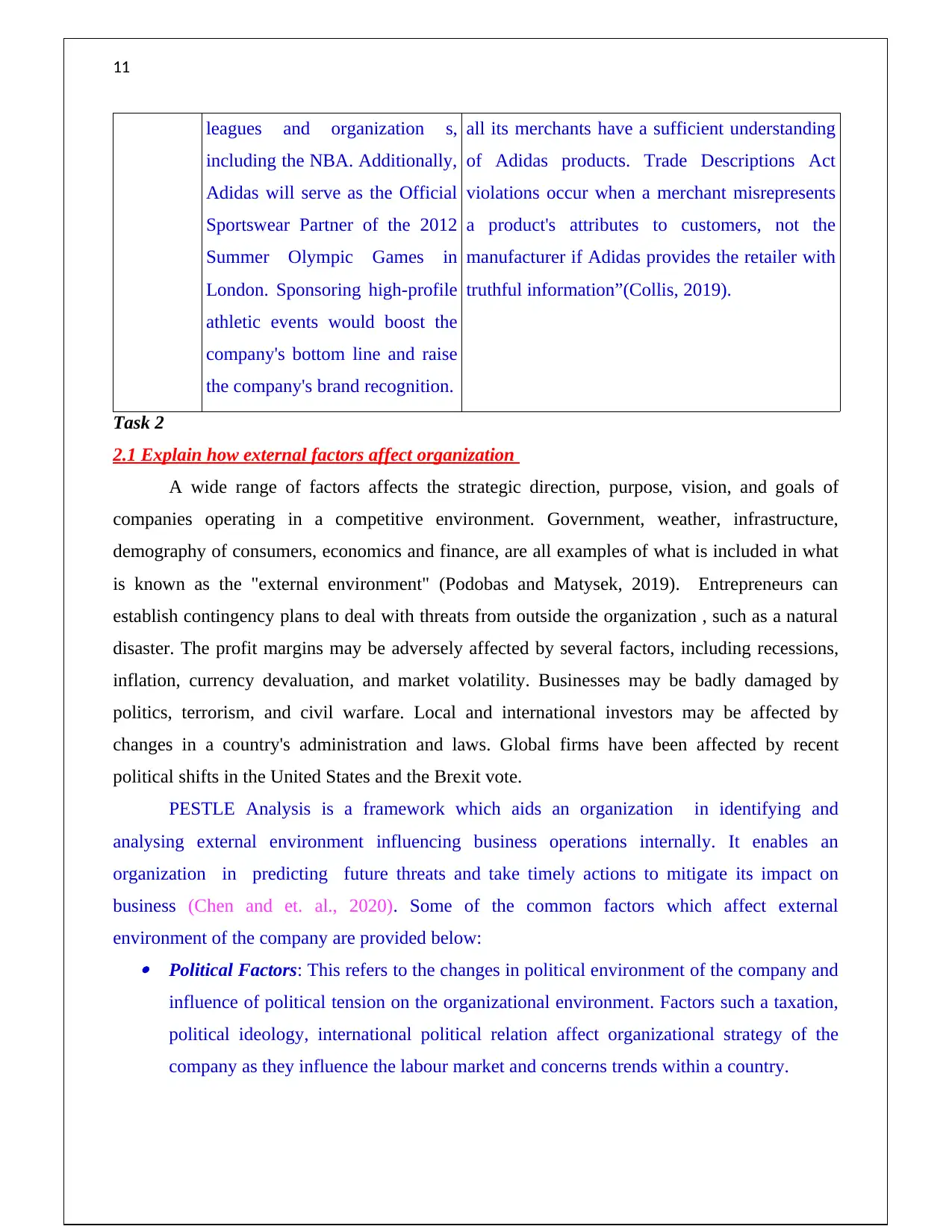
11
leagues and organization s,
including the NBA. Additionally,
Adidas will serve as the Official
Sportswear Partner of the 2012
Summer Olympic Games in
London. Sponsoring high-profile
athletic events would boost the
company's bottom line and raise
the company's brand recognition.
all its merchants have a sufficient understanding
of Adidas products. Trade Descriptions Act
violations occur when a merchant misrepresents
a product's attributes to customers, not the
manufacturer if Adidas provides the retailer with
truthful information”(Collis, 2019).
Task 2
2.1 Explain how external factors affect organization
A wide range of factors affects the strategic direction, purpose, vision, and goals of
companies operating in a competitive environment. Government, weather, infrastructure,
demography of consumers, economics and finance, are all examples of what is included in what
is known as the "external environment" (Podobas and Matysek, 2019). Entrepreneurs can
establish contingency plans to deal with threats from outside the organization , such as a natural
disaster. The profit margins may be adversely affected by several factors, including recessions,
inflation, currency devaluation, and market volatility. Businesses may be badly damaged by
politics, terrorism, and civil warfare. Local and international investors may be affected by
changes in a country's administration and laws. Global firms have been affected by recent
political shifts in the United States and the Brexit vote.
PESTLE Analysis is a framework which aids an organization in identifying and
analysing external environment influencing business operations internally. It enables an
organization in predicting future threats and take timely actions to mitigate its impact on
business (Chen and et. al., 2020). Some of the common factors which affect external
environment of the company are provided below: Political Factors: This refers to the changes in political environment of the company and
influence of political tension on the organizational environment. Factors such a taxation,
political ideology, international political relation affect organizational strategy of the
company as they influence the labour market and concerns trends within a country.
leagues and organization s,
including the NBA. Additionally,
Adidas will serve as the Official
Sportswear Partner of the 2012
Summer Olympic Games in
London. Sponsoring high-profile
athletic events would boost the
company's bottom line and raise
the company's brand recognition.
all its merchants have a sufficient understanding
of Adidas products. Trade Descriptions Act
violations occur when a merchant misrepresents
a product's attributes to customers, not the
manufacturer if Adidas provides the retailer with
truthful information”(Collis, 2019).
Task 2
2.1 Explain how external factors affect organization
A wide range of factors affects the strategic direction, purpose, vision, and goals of
companies operating in a competitive environment. Government, weather, infrastructure,
demography of consumers, economics and finance, are all examples of what is included in what
is known as the "external environment" (Podobas and Matysek, 2019). Entrepreneurs can
establish contingency plans to deal with threats from outside the organization , such as a natural
disaster. The profit margins may be adversely affected by several factors, including recessions,
inflation, currency devaluation, and market volatility. Businesses may be badly damaged by
politics, terrorism, and civil warfare. Local and international investors may be affected by
changes in a country's administration and laws. Global firms have been affected by recent
political shifts in the United States and the Brexit vote.
PESTLE Analysis is a framework which aids an organization in identifying and
analysing external environment influencing business operations internally. It enables an
organization in predicting future threats and take timely actions to mitigate its impact on
business (Chen and et. al., 2020). Some of the common factors which affect external
environment of the company are provided below: Political Factors: This refers to the changes in political environment of the company and
influence of political tension on the organizational environment. Factors such a taxation,
political ideology, international political relation affect organizational strategy of the
company as they influence the labour market and concerns trends within a country.

12
Economic Factors: This external environment factor refers to the unemployment rate,
currency fluctuation, free trade, rising taxes, consumer spending power and other
economic indicators of a region. These factors have direct impact on an organization
because they influence price of goods, raw material and consumer purchasing power. Social Factors: The social factors of demographic changes, changes in social trends
behaviors and values affect the consumers preferences and directly impact growth of the
firm. Technological Factors: Technology plays a important role in the growth of any
organization (Yeğin, 2020). Hence, companies are suppose to use modern technology. In
this way it influences business strategy of the organization. Environmental Factors: Sustainability is an important factor which affects growth of
businesses. This is because consumers are currently demanding more susta8inable
products and service to avoid contribution to climate change and global warming.
Legal Factors: The legal factor refers to rules legislation and regulations implemented by
national governments and international authorities. Businesses have to develop business
strategy in accordance with these legal factors in order to avoid legal trouble (Agwu,
2018).
Changing the external environment of activity may have a wide range of effects. One of
the most significant external influences on a company's mission, vision, and strategy in the state
of the world economy. A company's ability to influence what happens beyond its walls is quite
limited. A company's activities may have to be restructured or expanded if new regulations are
implemented in a specific place. Storms, hurricanes, and tornadoes all have the potential to
disrupt routine business operations, such as air travel and vacations, to some significant degree.
Poor infrastructure may harm retailers, manufacturers, and other businesses (Toke and Kalpande,
2021). A new marketing strategy may be required to keep up with the times because of changes
in the neighborhood's fashion or clientele. External outcomes are those over which a company
has no direct say. When reacting to external changes in the market or the economy, managers
must be dynamic, swift, and on the lookout.
2.2 Evaluate how stakeholder expectations influence organization s.
Economic Factors: This external environment factor refers to the unemployment rate,
currency fluctuation, free trade, rising taxes, consumer spending power and other
economic indicators of a region. These factors have direct impact on an organization
because they influence price of goods, raw material and consumer purchasing power. Social Factors: The social factors of demographic changes, changes in social trends
behaviors and values affect the consumers preferences and directly impact growth of the
firm. Technological Factors: Technology plays a important role in the growth of any
organization (Yeğin, 2020). Hence, companies are suppose to use modern technology. In
this way it influences business strategy of the organization. Environmental Factors: Sustainability is an important factor which affects growth of
businesses. This is because consumers are currently demanding more susta8inable
products and service to avoid contribution to climate change and global warming.
Legal Factors: The legal factor refers to rules legislation and regulations implemented by
national governments and international authorities. Businesses have to develop business
strategy in accordance with these legal factors in order to avoid legal trouble (Agwu,
2018).
Changing the external environment of activity may have a wide range of effects. One of
the most significant external influences on a company's mission, vision, and strategy in the state
of the world economy. A company's ability to influence what happens beyond its walls is quite
limited. A company's activities may have to be restructured or expanded if new regulations are
implemented in a specific place. Storms, hurricanes, and tornadoes all have the potential to
disrupt routine business operations, such as air travel and vacations, to some significant degree.
Poor infrastructure may harm retailers, manufacturers, and other businesses (Toke and Kalpande,
2021). A new marketing strategy may be required to keep up with the times because of changes
in the neighborhood's fashion or clientele. External outcomes are those over which a company
has no direct say. When reacting to external changes in the market or the economy, managers
must be dynamic, swift, and on the lookout.
2.2 Evaluate how stakeholder expectations influence organization s.
⊘ This is a preview!⊘
Do you want full access?
Subscribe today to unlock all pages.

Trusted by 1+ million students worldwide
1 out of 38
Related Documents
Your All-in-One AI-Powered Toolkit for Academic Success.
+13062052269
info@desklib.com
Available 24*7 on WhatsApp / Email
![[object Object]](/_next/static/media/star-bottom.7253800d.svg)
Unlock your academic potential
Copyright © 2020–2026 A2Z Services. All Rights Reserved. Developed and managed by ZUCOL.




